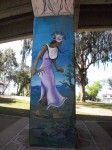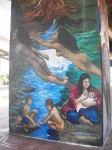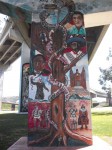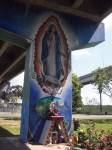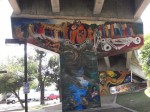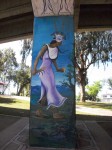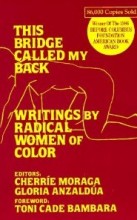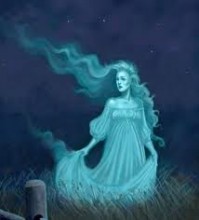 The La llorona story has been passed down in the areas of Mexico, the American Southwest, Puerto Rico and Central America for hundreds of years. Even though the story tends to vary depending on which region you hear it from, they tend to all have the same themes. The legend always consist of a beautiful woman named Maria that had kids, the kids end up dying somehow, and the woman’s ghost is always found around bodies of water. According to La LLorona by Joe Hayes, Maria was a very pretty and proud woman that vowed to only marry the most handsome man. She ended up getting engaged to a handsome ranchero, and they had a couple of kids over the years. The ranchero started paying less attention to Maria, but more to his kids, and he would even go away to prairies and wildlife for months at a time without seeing her. One day he came back home on a carriage with a beautiful woman and he only acknowledged his kids, but ignored Maria. Maria got so jealous of her children getting all the attention from her husband, that she drowning them. After she realized what she had done, she drowned herself as well. The first night she is buried, her cry of “where are my children?” can be heard in the night.
The La llorona story has been passed down in the areas of Mexico, the American Southwest, Puerto Rico and Central America for hundreds of years. Even though the story tends to vary depending on which region you hear it from, they tend to all have the same themes. The legend always consist of a beautiful woman named Maria that had kids, the kids end up dying somehow, and the woman’s ghost is always found around bodies of water. According to La LLorona by Joe Hayes, Maria was a very pretty and proud woman that vowed to only marry the most handsome man. She ended up getting engaged to a handsome ranchero, and they had a couple of kids over the years. The ranchero started paying less attention to Maria, but more to his kids, and he would even go away to prairies and wildlife for months at a time without seeing her. One day he came back home on a carriage with a beautiful woman and he only acknowledged his kids, but ignored Maria. Maria got so jealous of her children getting all the attention from her husband, that she drowning them. After she realized what she had done, she drowned herself as well. The first night she is buried, her cry of “where are my children?” can be heard in the night.
The La llorona legend represents a bad women and how women are not supposed to behave towards their children. The message that the La llorona legend teaches is that no matter what sacrifice a woman has to make, no sacrifice is to big for your children, if you are a good mother. Maria in the story is depicted as a bad mother because she couldn’t sacrifice the lack of receiving attention from her husband, to just be content with being a good mother to her kids. If she had put her children first and continued to care and love them, even when her husband ignored her needs, she would’ve been considered a good mom.
Putting your children first is very difficult for some mothers to do because they are pressured to sacrifice and suffer for their families, while such pressures aren’t expected of the men. In The Women of La Raza by Enriqueta Longeaux Vasquez, Enriqueta touches on the point of this double standard between the Chicano/a men and women concerning child raising. She describes the expected responsibility of a Chicana woman for her family when her husband divorces or separates from her as,
“ In order to find a way to feed and clothe her family, she must find a job… She is probably unable to find a job that will pay her a decent wage. If she is able to find a job at all, it will probably be sought only for survival. Thus she can hope just to exist; she will hardly be able to live an enjoyable life (pg 30 La Raza).”
It is automatically assumed in the quote, as well as in the La llorona legend that it is all right the man to just leave the children anytime he feels like it and place the responsibility on the wife to take care of them. In the La llorona legend, the husband would go to the wilderness for months at a time and not see the kids, but when he returned home, the kids and the father still had a mutually loving relationship.
Sources:
1. http://articles.ivpressonline.com/2011-10-30/la-llorona_30340267
2. http://www.literacynet.org/lp/hperspectives/llorona.html
3. http://en.wikipedia.org/wiki/La_Llorona
4. Chicana Feminist Thought by Alma García. Pg 29-31

 I picked up the first thing that caught my eye. It was a thin pamphlet, in photocopied black and white, with an anarchy symbol and the title “Anarchist Queer Person of Color” handwritten across the front. Cautiously I opened it. I read its intoxicating eight pages three times in quick succession. I closed it, and looked around, wondering how my mind could have expanded so vastly without anyone around me noticing. I read it once again, slowly, letting each of the ideas it presented bounce around in my headspace and develop. Truthfully, the zine presented me with more questions that answers. In light of this Chicana Feminism class I find myself in, I was left with, and am still left with, one main question: Is anarchy the natural progression of feminism, especially for women of color?
I picked up the first thing that caught my eye. It was a thin pamphlet, in photocopied black and white, with an anarchy symbol and the title “Anarchist Queer Person of Color” handwritten across the front. Cautiously I opened it. I read its intoxicating eight pages three times in quick succession. I closed it, and looked around, wondering how my mind could have expanded so vastly without anyone around me noticing. I read it once again, slowly, letting each of the ideas it presented bounce around in my headspace and develop. Truthfully, the zine presented me with more questions that answers. In light of this Chicana Feminism class I find myself in, I was left with, and am still left with, one main question: Is anarchy the natural progression of feminism, especially for women of color?
